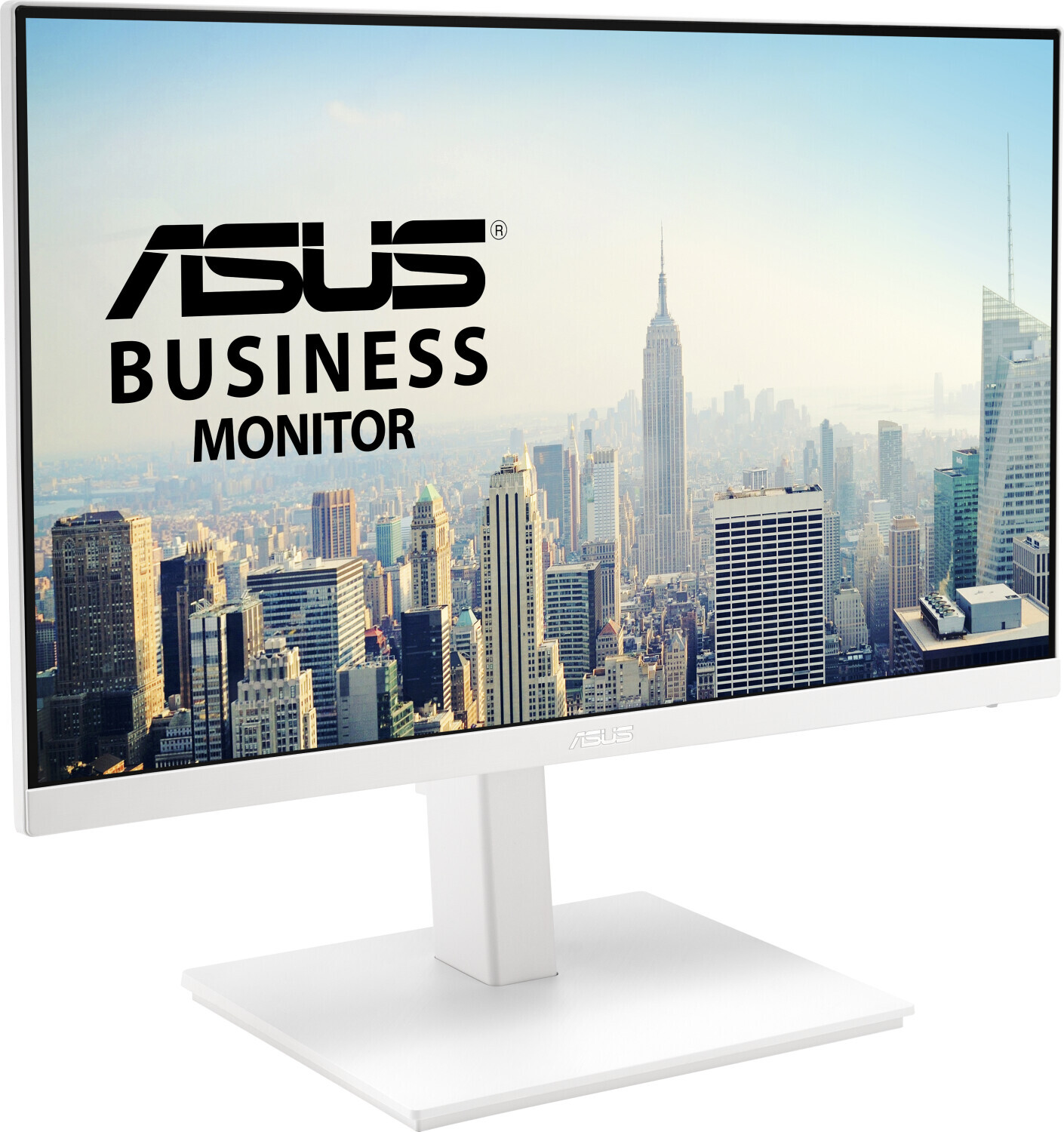







































£128.99*
- Resolution 1920 x 1080 Full HD
- Diagonal 24"
- Panel type IPS
- Refresh Rate 75Hz



Product information
ASUS VA24EQSB-W Business Monitor - 23.8-inch, Full HD, IPS, frameless, 75Hz, Adaptive-Sync, low blue light, flicker-free, ergonomic design, wall-mountable
- 23.8-inch Full HD (1920 x 1080) display with IPS panel and 178° wide viewing angle
- Up to 75 Hz refresh rate with Adaptive Sync technology to prevent tracing and provide crisp and clear video playback
- Comprehensive connectivity options including HDMI, DisplayPort, D-Sub and USB hub
- Ergonomic design with +35° ~ -5° tilt, ±180° swivel, ±90° tilt and 130 mm height adjustment for a comfortable viewing experience
- ASUS Eye Care monitors feature TÜV Rheinland-certified flicker-free and blue light filter technologies, to ensure a comfortable viewing experience
- Supports both Adaptive-Sync with NVIDIA GeForce graphics cards and FreeSync with AMD Radeon graphics cards Compatible with NVIDIA GeForce GTX 10 series, GTX 16 series, RTX 20 series and newer graphics cards
VA24EQSB-W Business Monitor
The ASUS VA24EQSB-W is a 23.8-inch full HD monitor with a bezel-less IPS panel for wide-angle viewing that delivers incredibly sharp images and stunning video playback. Up to 75Hz refresh rate with Adaptive Sync technology to eliminate tracing and deliver crisp and clear video playback. The highly ergonomic design with tilt, swivel, pivot and height adjustment, as well as the TÜV Rheinland-certified flicker-free and blue light filter, ensure a comfortable viewing experience.
Natural views with 178° wide viewing angle
The Full HD resolution and frameless IPS panel offer a 178° viewing angle both horizontally and vertically, so you can enjoy the stunning picture reproduction from almost any direction.
Comprehensive connectivity
Numerous connectivity options, including HDMI, DisplayPort, D-Sub and USB hub, allow you to easily connect to a variety of PCs, laptops, consoles, media boxes, keyboards and mice. In addition, the monitor has line-in and headphone jacks so you can conveniently connect your audio devices.
Versatile, ergonomic stand for individual comfort
Thanks to the ergonomic stand with tilt, swivel, pivot and height adjustment, a comfortable viewing position is always within reach. Thus, the stand offers an excellent range of viewing options for increased productivity and comfort. The screen can also be rotated vertically by 90 degrees for use in portrait mode. This is a great advantage when working with long documents, writing code or browsing long websites.
Integrated stereo speakers for multimedia
With two integrated speakers, the VA24EQSB-W enriches your audiovisual experience and ensures limitless entertainment and multimedia enjoyment.
ASUS Blue Light Filter
The exclusive ASUS Blue Light Filter protects you from harmful blue light. It's user-friendly, intuitive and flexible with seamless adjustment (0 to maximum) via the OSD menu.
ASUS Flicker-Free Technology
It's time to say goodbye to tired, strained eyes. Flicker-Free technology reduces flicker on the screen, providing a comfortable environment to enjoy a movie marathon. It's designed to minimise eyestrain, headaches and eye fatigue - symptoms that can occur after countless hours in front of the screen.
Exclusive ASUS features for added versatility
Splendid™ Video Intelligence technology
ASUS Splendid™ technology that optimises videos and images by enhancing colour brightness, contrast and sharpness. It has a variety of modes, including Reading, Darkroom, Scenery, Standard, Theatre, sRGB, Game and Night View.
Intelligent cable management
Cable management helps you organise and hide various cables to keep your desk tidy.
Technical data
| Name | Asus VA24EQSB-W 24" Business Monitor 24" IPS Monitor, 1920 x 1080 Full HD, 75Hz, 5ms |
|---|---|
| Article number | 1000026117 |
| GTIN/EAN | 4711081867449 |
| Manufacturer SKU | VA24EQSB-W |
| EPREL ID | 1329243 |
| Model name | VA24EQSB-W 24" Business Monitor |
| Brand | Asus |
| Product Type | Monitor |
| Technology | LCD |
| Panel type | IPS |
| Resolution | 1920 x 1080 Full HD |
| Diagonal | 24" |
| Aspect Ratio | 16:9 |
| Viewing angle - Horizontal | 178° |
| Viewing angle - Vertical | 178° |
| Contrast Ratio | 1,200 :1 |
| Max. Brightness | 350 cd/m² |
| Response time | 5ms |
| Refresh Rate | 75Hz |
| Support - VESA | 100 x 100 |
| Inputs | 1x 3,5mm Jack , 1x Displayport , 1x HDMI , 1x VGA , 2x USB-A |
| Features | Flicker Free , Integrated speaker |
| Product width | 54.04 cm |
| Product height | 32.5 cm |
| Product depth | 4.44 cm |
| Weight | 3.2 kg |
| Colour | White |
| EEK Spectrum | A to G |
| Energy efficency class | E |
| Delivery contents | HDMI Cable , Power cable , USB cable |
| Condition | New |
| Warranty | 24 Month |
| Warranty type | Bringin service Service and support information |
Downloads
Product safety
| Person responsible for the EU |
|---|
| Ninepoint GmbH |
| Im Mediapark 8 |
| 50670 Köln |
| Germany |
| info@asus-shop.de |



